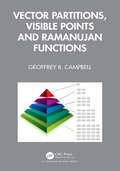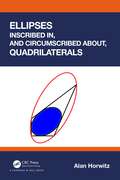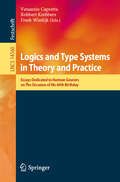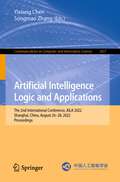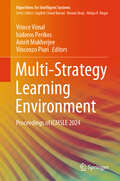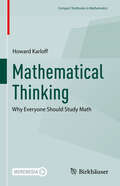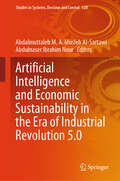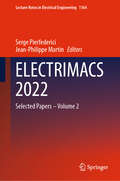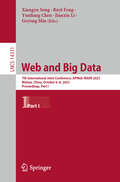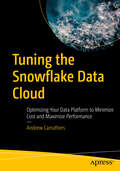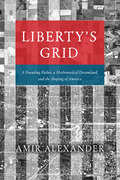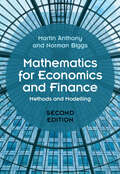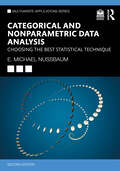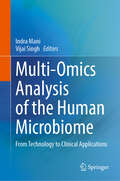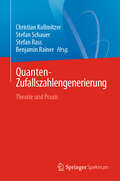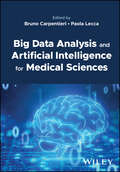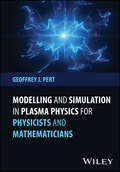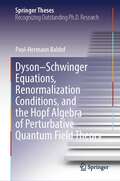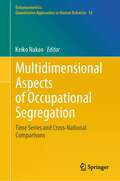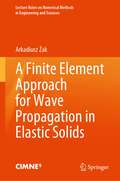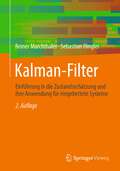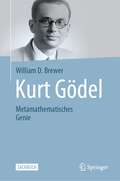- Table View
- List View
Vector Partitions, Visible Points and Ramanujan Functions
by Geoffrey B. CampbellVector Partitions, Visible Points and Ramanujan Functions offers a novel theory of Vector Partitions, though very much grounded in the long-established work of others, that could be developed as an extension to the existing theory of Integer Partitions. The book is suitable for graduate students in physics, applied mathematics, number theory and computational mathematics. It takes the reader up to research level, presenting new results alongside known classical results from integer partitions and areas of vector and multipartite partition theory. It also sets forth new directions for research for the more advanced reader.Above all, the intention of the book is to bring new inspiration to others who study mathematics and related areas. It is hoped that some new ideas will be launched to add value and insight into many of the classical and new theories surrounding partitions. The book is an appreciation of the many gifted authors of research into partitions over the past century and before, in the hope that more may come of this for future generations.Features Provides a step-by-step guide through the known literature on Integer and Vector Partitions, and a focus on the not so well-known Visible Point Vector identities Serves as a reference for graduate students and researchers in physics, applied mathematics, number theory and computational mathematics Offers a variety of practical examples as well as sets of exercises suitable for students and researchers Geoffrey B. Campbell completed his PhD at Australian National University in 1998 under the esteemed physicist Professor Rodney Baxter. His affiliation with the Australian National University Mathematical Sciences Institute has continued for over 30 years. Within that time frame, Geoffrey also served eight years as an Honorary Research Fellow at LaTrobe University Mathematics and Statistics Department in Melbourne. Currently he writes ongoing articles for the Australian Mathematical Society Gazette. Within the international scope, Geoffrey currently serves as a PhD external committee member for a mathematics graduate student at Washington State University in America.Geoffrey has built a career within Australian Commonwealth and State government departments, including as an Advisor at the Department of Prime Minister and Cabinet; as Analyst Researcher for a Royal Commission. Geoffrey specializes in complex data, machine learning including data analytics. He is also a published poet in Australian anthologies and literary magazines.
Ellipses Inscribed in, and Circumscribed about, Quadrilaterals
by Alan HorwitzThe main focus of this book is disseminating research results regarding the pencil of ellipses inscribing arbitrary convex quadrilaterals. In particular, the author proves that there is a unique ellipse of maximal area, EA, and a unique ellipse of minimal eccentricity, EI, inscribed in Q. Similar results are also proven for ellipses passing through the vertices of a convex quadrilateral along with some comparisons with inscribed ellipses. Special results are also given for parallelograms.Researchers in geometry and applied mathematics will find this unique book of interest. Software developers, image processors along with geometers, mathematicians, and statisticians will be very interested in this treatment of the subject of inscribing and circumscribing ellipses with the comprehensive treatment here.Most of the results in this book were proven by the author in several papers listed in the references at the end. This book gathers results in a unified treatment of the topics while also shortening and simplifying many of the proofs.This book also contains a separate section on algorithms for finding ellipses of maximal area or of minimal eccentricity inscribed in, or circumscribed about, a given quadrilateral and for certain other topics treated in this book.Anyone who has taken calculus and linear algebra and who has a basic understanding of ellipses will find it accessible.
Ellipses Inscribed in, and Circumscribed about, Quadrilaterals
by Alan HorwitzThe main focus of this book is disseminating research results regarding the pencil of ellipses inscribing arbitrary convex quadrilaterals. In particular, the author proves that there is a unique ellipse of maximal area, EA, and a unique ellipse of minimal eccentricity, EI, inscribed in Q. Similar results are also proven for ellipses passing through the vertices of a convex quadrilateral along with some comparisons with inscribed ellipses. Special results are also given for parallelograms.Researchers in geometry and applied mathematics will find this unique book of interest. Software developers, image processors along with geometers, mathematicians, and statisticians will be very interested in this treatment of the subject of inscribing and circumscribing ellipses with the comprehensive treatment here.Most of the results in this book were proven by the author in several papers listed in the references at the end. This book gathers results in a unified treatment of the topics while also shortening and simplifying many of the proofs.This book also contains a separate section on algorithms for finding ellipses of maximal area or of minimal eccentricity inscribed in, or circumscribed about, a given quadrilateral and for certain other topics treated in this book.Anyone who has taken calculus and linear algebra and who has a basic understanding of ellipses will find it accessible.
Logics and Type Systems in Theory and Practice: Essays Dedicated to Herman Geuvers on The Occasion of His 60th Birthday (Lecture Notes in Computer Science #14560)
by Freek Wiedijk Venanzio Capretta Robbert KrebbersThis Festschrift, dedicated to Herman Geuvers on the occasion of his 60th birthday, contains papers written by many of his closest collaborators. Herman Geuvers is a full professor at Radboud University Nijmegen and holds a part-time professorship at Eindhoven University of Technology. He received his PhD from Radboud University in 1993 and he was promoted to full professor in Computer Assisted Reasoning in 2006. Prof. Geuvers is an internationally renowned researcher in the field of proof assistants, logic in computer science, lambda calculus, and type theory. He has been a steering committee chair of the TYPES and FSCD conferences, chair of related EU Cost Action projects, and program chair or editor of related conferences and special issues in the area of computer science logic. He is a successful, generous and inspiring advisor and educator. He has been director of education and director of research of the Computer Science Institute at Radboud University Nijmegen, and he is currently chair of the examination board of computer science and chair of the board of the Institute for Programming Research and Algorithmics, a Dutch national inter-university research school. The contributions in this volume reflect Prof. Geuvers’ main research interests.
Artificial Intelligence Logic and Applications: The 2nd International Conference, AILA 2022, Shanghai, China, August 26–28, 2022, Proceedings (Communications in Computer and Information Science #1657)
by Songmao Zhang Yixiang ChenThis book constitutes refereed proceedings of the 2nd International Conference on Artificial Intelligence Logic and Applications 2022 held in Shanghai, China from August 26–28, 2022.The 20 full papers presented in this volume were carefully reviewed and selected from a total of 27 submissions. The papers in the volume are organised according to the following topical headings: program logic; fuzzy logic; applications; author index.
Multi-Strategy Learning Environment: Proceedings of ICMSLE 2024 (Algorithms for Intelligent Systems)
by Vincenzo Piuri Isidoros Perikos Vrince Vimal Amrit MukherjeeThe book presents selected papers from International Conference on Multi-Strategy Learning Environment (ICMSLE 2024), held at Graphic Era Hill University, Dehradun, India, during 12–13 January 2024. This book presents current research in machine learning techniques, deep learning theories and practices, interpretability and explainability of AI algorithms, game theory and learning, multi-strategy learning (MSL) in distributed and streaming environments, and adaptive data analysis and selective inference.
Mathematical Thinking: Why Everyone Should Study Math (Compact Textbooks in Mathematics)
by Howard KarloffThis textbook invites readers to explore mathematical thinking by finding the beauty in the subject. With an accessible tone and stimulating puzzles, the author will convince curious non-mathematicians to continue their studies in the area. It has an expansive scope, covering everything from probability and graph theory to infinities and Newton’s method. Many examples of proofs appear as well, offering readers the opportunity to explore these topics with the amount of rigor that suits them. Programming exercises in Python are also included to show how math behaves in action.Mathematical Thinking is an ideal textbook for transition courses aimed at undergraduates moving from lower level to more advanced topics, as well as for math recruitment and invitational courses at the freshman or sophomore level. It may also be of interest in computer science departments and can be used as a supplemental text for courses in discrete mathematics and graph theory.
Artificial Intelligence and Economic Sustainability in the Era of Industrial Revolution 5.0 (Studies in Systems, Decision and Control #528)
by Abdalmuttaleb M. A. Musleh Al-Sartawi Abdulnaser Ibrahim NourIndustry 5.0 has been dubbed as the digital revolution with a soul. This book incorporates a wealth of research which integrates artificial intelligence (AI) with economic sustainability and Industry 5.0. It examines the human-centricity of the upcoming digital revolution and the role of sustainable technologies in enhancing the livelihoods of workers, individuals, communities, and eventually societies. It provides insight on important areas related to artificial intelligence, sustainable development, and society 5.0. The chapters present a wide range of topics including block cipher, entrepreneurship and AI, AI and stock trading decisions, digital transformation, knowledge management, chatbot engineering, cybersecurity, and smart metering system. This book is beneficial to scholars and academics who will find in it the knowledge of the support of AI and its contribution to economic sustainability, and solutions to enhance human-centricity and resilience.
ELECTRIMACS 2022: Selected Papers – Volume 2 (Lecture Notes in Electrical Engineering #1164)
by Serge Pierfederici Jean-Philippe MartinThis book collects a selection of papers presented at ELECTRIMACS, 2022 the14th international conference of the IMACS TC1 Committee, held in Nancy, France, on 17st-21rd May 2022. The conference papers deal with modelling, simulation, analysis, control, power management, design optimization, identification and diagnostics in electrical power engineering. The main application fields include electric machines and electromagnetic devices, power electronics, transportation systems, smart grids, electric and hybrid vehicles, renewable energy systems, energy storage, batteries, supercapacitors and fuel cells, and wireless power transfer. The contributions included in Volume 2 are particularly focused on methodological aspects, modelling, and applied mathematics in the field of electrical engineering.
Web and Big Data: 7th International Joint Conference, APWeb-WAIM 2023, Wuhan, China, October 6–8, 2023, Proceedings, Part I (Lecture Notes in Computer Science #14331)
by Jianxin Li Geyong Min Xiangyu Song Ruyi Feng Yunliang ChenThe 4-volume set LNCS 14331, 14332, 14333, and 14334 constitutes the refereed proceedings of the 7th International Joint Conference, APWeb-WAIM 2023, which took place in Wuhan, China, in October 2023. The total of 138 papers included in the proceedings were carefully reviewed and selected from 434 submissions. They focus on innovative ideas, original research findings, case study results, and experienced insights in the areas of the World Wide Web and big data, covering Web technologies, database systems, information management, software engineering, knowledge graph, recommend system and big data.
Tuning the Snowflake Data Cloud: Optimizing Your Data Platform to Minimize Cost and Maximize Performance
by Andrew CarruthersThis project-oriented book presents a hands-on approach to identifying migration and performance issues with experience drawn from real-world examples. As you work through the book, you will develop skills, knowledge, and deep understanding of Snowflake tuning options and capabilities while preparing for later incorporation of additional Snowflake features as they become available. Your Snowflake platform will cost less to run and will improve your customer experience. Written by a seasoned Snowflake practitioner, this book is full of practical, hands-on guidance and advice specifically designed to further accelerate your Snowflake journey. Tuning the Snowflake Data Cloud provides you a pathway to success by equipping you with the skills, knowledge, and expertise needed to elevate your Snowflake experience. The book shows you how to leverage what you already know, adds what you don’t, and helps you apply it toward delivering for your Snowflake accounts. Read this book to embark on a voyage of advancement and equip your organization to deliver consistent Snowflake performance. What You Will Learn Recognize and understand the root cause of performance bottlenecks Know how to resolve performance issues Develop a deep understanding of Snowflake performance tuning options Reduce expensive mistakes, remediate poorly performing code Manage Snowflake costs
Liberty's Grid: A Founding Father, a Mathematical Dreamland, and the Shaping of America
by Amir AlexanderThe surprising history behind a ubiquitous facet of the United States: the gridded landscape. Seen from an airplane, much of the United States appears to be a gridded land of startling uniformity. Perpendicular streets and rectangular fields, all precisely measured and perfectly aligned, turn both urban and rural America into a checkerboard landscape that stretches from horizon to horizon. In evidence throughout the country, but especially the West, the pattern is a hallmark of American life. One might consider it an administrative convenience—an easy way to divide land and lay down streets—but it is not. The colossal grid carved into the North American continent, argues historian and writer Amir Alexander, is a plan redolent with philosophical and political meaning. In 1784 Thomas Jefferson presented Congress with an audacious scheme to reshape the territory of the young United States. All western lands, he proposed, would be inscribed with a single rectilinear grid, transforming the natural landscape into a mathematical one. Following Isaac Newton and John Locke, he viewed mathematical space as a blank slate on which anything is possible and where new Americans, acting freely, could find liberty. And if the real America, with its diverse landscapes and rich human history, did not match his vision, then it must be made to match it. From the halls of Congress to the open prairies, and from the fight against George III to the Trail of Tears, Liberty’s Grid tells the story of the battle between grid makers and their opponents. When Congress endorsed Jefferson’s plan, it set off a struggle over American space that has not subsided. Transcendentalists, urban reformers, and conservationists saw the grid not as a place of possibility but as an artificial imposition that crushed the human spirit. Today, the ideas Jefferson associated with the grid still echo through political rhetoric about the country’s founding, and competing visions for the nation are visible from Manhattan avenues and Kansan pastures to Yosemite’s cliffs and suburbia’s cul-de-sacs. An engrossing read, Liberty’s Grid offers a powerful look at the ideological conflict written on the landscape.
Liberty's Grid: A Founding Father, a Mathematical Dreamland, and the Shaping of America
by Amir AlexanderThe surprising history behind a ubiquitous facet of the United States: the gridded landscape. Seen from an airplane, much of the United States appears to be a gridded land of startling uniformity. Perpendicular streets and rectangular fields, all precisely measured and perfectly aligned, turn both urban and rural America into a checkerboard landscape that stretches from horizon to horizon. In evidence throughout the country, but especially the West, the pattern is a hallmark of American life. One might consider it an administrative convenience—an easy way to divide land and lay down streets—but it is not. The colossal grid carved into the North American continent, argues historian and writer Amir Alexander, is a plan redolent with philosophical and political meaning. In 1784 Thomas Jefferson presented Congress with an audacious scheme to reshape the territory of the young United States. All western lands, he proposed, would be inscribed with a single rectilinear grid, transforming the natural landscape into a mathematical one. Following Isaac Newton and John Locke, he viewed mathematical space as a blank slate on which anything is possible and where new Americans, acting freely, could find liberty. And if the real America, with its diverse landscapes and rich human history, did not match his vision, then it must be made to match it. From the halls of Congress to the open prairies, and from the fight against George III to the Trail of Tears, Liberty’s Grid tells the story of the battle between grid makers and their opponents. When Congress endorsed Jefferson’s plan, it set off a struggle over American space that has not subsided. Transcendentalists, urban reformers, and conservationists saw the grid not as a place of possibility but as an artificial imposition that crushed the human spirit. Today, the ideas Jefferson associated with the grid still echo through political rhetoric about the country’s founding, and competing visions for the nation are visible from Manhattan avenues and Kansan pastures to Yosemite’s cliffs and suburbia’s cul-de-sacs. An engrossing read, Liberty’s Grid offers a powerful look at the ideological conflict written on the landscape.
Mathematics for Economics and Finance: Methods and Modelling
by null Martin Anthony null Norman BiggsAccessible, concise, and interactive, this book introduces the mathematical methods that are indispensable in economics and finance. Fully updated to be as student friendly as possible, this edition contains extensive problems, worked examples and exercises (with full solutions at the end of the book). Two brand new chapters cover coupled systems of recurrence/differential equations, and matrix diagonalisation. All topics are motivated by problems from economics and finance, demonstrating to students how they can apply the mathematical techniques covered. For undergraduate students of economics, mathematics, or both, this book will be welcomed for its clarity and breadth and the many opportunities it provides for readers to practise and test their understanding.
Categorical and Nonparametric Data Analysis: Choosing the Best Statistical Technique (Multivariate Applications Series)
by E. Michael NussbaumNow in its second edition, this book provides a focused, comprehensive overview of both categorical and nonparametric statistics, offering a conceptual framework for choosing the most appropriate test in various scenarios. The book’s clear explanations and Exploring the Concept boxes help reduce reader anxiety. Problems inspired by actual studies provide meaningful illustrations of these techniques. Basic statistics and probability are reviewed for those needing a refresher with mathematical derivations placed in optional appendices.Highlights include the following:• Three chapters co-authored with Edgar Brunner address modern nonparametric techniques, along with accompanying R code.• Unique coverage of both categorical and nonparametric statistics better prepares readers to select the best technique for particular research projects.• Designed to be used with most statistical packages, clear examples of how to use the tests in SPSS, R, and Excel foster conceptual understanding.• Exploring the Concept boxes integrated throughout prompt students to draw links between the concepts to deepen understanding.• Fully developed Instructor and Student Resources featuring datasets for the book's problems and a guide to R, and for the instructor PowerPoints, author's syllabus, and answers to even-numbered problems.Intended for graduate or advanced undergraduate courses in categorical and nonparametric statistics taught in psychology, education, human development, sociology, political science, and other social and life sciences.
Categorical and Nonparametric Data Analysis: Choosing the Best Statistical Technique (Multivariate Applications Series)
by E. Michael NussbaumNow in its second edition, this book provides a focused, comprehensive overview of both categorical and nonparametric statistics, offering a conceptual framework for choosing the most appropriate test in various scenarios. The book’s clear explanations and Exploring the Concept boxes help reduce reader anxiety. Problems inspired by actual studies provide meaningful illustrations of these techniques. Basic statistics and probability are reviewed for those needing a refresher with mathematical derivations placed in optional appendices.Highlights include the following:• Three chapters co-authored with Edgar Brunner address modern nonparametric techniques, along with accompanying R code.• Unique coverage of both categorical and nonparametric statistics better prepares readers to select the best technique for particular research projects.• Designed to be used with most statistical packages, clear examples of how to use the tests in SPSS, R, and Excel foster conceptual understanding.• Exploring the Concept boxes integrated throughout prompt students to draw links between the concepts to deepen understanding.• Fully developed Instructor and Student Resources featuring datasets for the book's problems and a guide to R, and for the instructor PowerPoints, author's syllabus, and answers to even-numbered problems.Intended for graduate or advanced undergraduate courses in categorical and nonparametric statistics taught in psychology, education, human development, sociology, political science, and other social and life sciences.
Multi-Omics Analysis of the Human Microbiome: From Technology to Clinical Applications
by Vijai Singh Indra ManiThis book introduces the rapidly evolving field of multi-omics in understanding the human microbiome. The book focuses on the technology used to generate multi-omics data, including advances in next-generation sequencing and other high-throughput methods. It also covers the application of artificial intelligence and machine learning algorithms to the analysis of multi-omics data, providing readers with an overview of the powerful computational tools that are driving innovation in this field. The chapter also explores the various bioinformatics databases and tools available for the analysis of multi-omics data. The book also delves into the application of multi-omics technology to the study of microbial diversity, including metagenomics, metatranscriptomics, and metaproteomics. The book also explores the use of these techniques to identify and characterize microbial communities in different environments, from the gut and oral microbiome to the skin microbiome and beyond. Towards theend, it focuses on the use of multi-omics in the study of microbial consortia, including mycology and the viral microbiome. The book also explores the potential of multi-omics to identify genes of biotechnological importance, providing readers with an understanding of the role that this technology could play in advancing biotech research. Finally, the book concludes with a discussion of the clinical applications of multi-omics technology, including its potential to identify disease biomarkers and develop personalized medicine approaches. Overall, this book provides readers with a comprehensive overview of this exciting field, highlighting the potential for multi-omics to transform our understanding of the microbial world.
Quanten-Zufallszahlengenerierung: Theorie und Praxis
by Stefan Rass Stefan Schauer Christian Kollmitzer Benjamin RainerDieses Buch bietet einen Überblick über die neuesten Implementierungen von Quanten-Zufallszahlengeneratoren (QRNGs) und untersucht insbesondere deren Beziehung zu klassischen statistischen Zufallsmodellen und numerischen Techniken zur Berechnung von Zufallszahlen. Der Leser - der idealerweise einen Hintergrund in klassischer Statistik, Informatik oder Kryptographie hat - wird Schritt für Schritt in die Welt der Quantenbits eingeführt, und es werden explizite Beziehungen zwischen QRNGs und ihren klassischen Gegenstücken aufgezeigt. Die Erzeugung von Zufallszahlen ist eine wichtige Säule der Kryptographie. Die Nutzung des Zufalls, der Quantenphänomenen innewohnt, ist ein sich rasch entwickelnder Zweig der Quantenkryptografie mit unzähligen Anwendungen für die Zukunft. Der Wert der Quantenzufälligkeit für kryptografische Zwecke wird empirisch durch statistische Auswertungen der Leistung von QRNGs im Vergleich zu klassischen Techniken zur Erzeugung echter und pseudozufälliger Zahlen nachgewiesen. Das Buch bietet dann einen Überblick über die technischen Implementierungen von QRNGs, bevor eine abschließende Diskussion über die wichtigsten Errungenschaften und verbleibenden Hindernisse auf diesem Gebiet die Berichterstattung abrundet und gleichzeitig die Tür für zukünftige Forschungsrichtungen öffnet.
Big Data Analysis and Artificial Intelligence for Medical Sciences
by Paola Lecca Bruno CarpentieriBig Data Analysis and Artificial Intelligence for Medical Sciences Overview of the current state of the art on the use of artificial intelligence in medicine and biology Big Data Analysis and Artificial Intelligence for Medical Sciences demonstrates the efforts made in the fields of Computational Biology and medical sciences to design and implement robust, accurate, and efficient computer algorithms for modeling the behavior of complex biological systems much faster than using traditional modeling approaches based solely on theory. With chapters written by international experts in the field of medical and biological research, Big Data Analysis and Artificial Intelligence for Medical Sciences includes information on: Studies conducted by the authors which are the result of years of interdisciplinary collaborations with clinicians, computer scientists, mathematicians, and engineers Differences between traditional computational approaches to data processing (those of mathematical biology) versus the experiment-data-theory-model-validation cycle Existing approaches to the use of big data in the healthcare industry, such as through IBM’s Watson Oncology, Microsoft’s Hanover, and Google’s DeepMind Difficulties in the field that have arisen as a result of technological changes, and potential future directions these changes may take A timely and up-to-date resource on the integration of artificial intelligence in medicine and biology, Big Data Analysis and Artificial Intelligence for Medical Sciences is of great benefit not only to professional scholars, but also MSc or PhD program students eager to explore advancement in the field.
Modelling and Simulation in Plasma Physics for Physicists and Mathematicians
by Geoffrey J. PertUnveiling the Secrets of Plasma Physics: A Practical Guide to Computational Simulations Plasma physics focuses on the most abundant state of matter in the universe, corresponding to ionized gas comprising ions and electrons. It can be created artificially and has a huge range of technological applications, from television displays to fusion energy research. Every application of plasma technology requires its own numerical solution to the complex physical and mathematical equations which govern the research field of plasma physics. Modelling and Simulation in Plasma Physics for Physicists and Mathematics offers an introduction to the principles of simulating plasma physics applications. It provides knowledge not only of the fundamental algorithms in computational fluid mechanics, but also their specific role in a plasma physics context. In addition, the book dissects the challenges and advancements, unveiling the delicate balance between accuracy and computational cost. Modelling and Simulation in Plasma Physics for Physicists and Mathematics readers will also find: Cutting-edge computational insights where powerful simulations meet theoretical complexities, providing physicists and mathematicians a gateway to cutting-edge research. An overview of programming language-agnostic code generation and the construction of adaptable models that resonate with the intricate dynamics of plasma physics, ensuring precision in every simulation. Advanced simplification strategies, including time splitting, analytic models, averaged rates, and tabular material, offering scientists and engineers a roadmap to balance computational demands with scientific rigor. Modelling and Simulation in Plasma Physics for Physicists and Mathematics is ideal for plasma physicists, students, and engineers looking to work with plasma technologies.
Dyson–Schwinger Equations, Renormalization Conditions, and the Hopf Algebra of Perturbative Quantum Field Theory (Springer Theses)
by Paul-Hermann BaldufThis book offers a systematic introduction to the Hopf algebra of renormalization in quantum field theory, with a special focus on physical motivation, the role of Dyson–Schwinger equations, and the renormalization group. All necessary physical and mathematical constructions are reviewed and motivated in a self-contained introduction. The main part of the book concerns the interplay between Dyson–Schwinger equations (DSEs) and renormalization conditions. The book is explicit and consistent about whether a statement is true in general or only in particular renormalization schemes or approximations and about the dependence of quantities on regularization parameters or coupling constants. With over 600 references, the original literature is cited whenever possible and the book contains numerous references to other works discussing further details, generalizations, or alternative approaches. There are explicit examples and remarks to make the connection from the scalar fields at hand toQED and QCD. The book is primarily targeted at the mathematically oriented physicist who seeks a systematic conceptual overview of renormalization, Hopf algebra, and DSEs. These may be graduate students entering the field as well as practitioners seeking a self-contained account of the Hopf algebra construction. Conversely, the book also benefits the mathematician who is interested in the physical background of the exciting interplay between Hopf algebra, combinatorics and physics that is renormalization theory today.
Multidimensional Aspects of Occupational Segregation: Time Series and Cross-National Comparisons (Behaviormetrics: Quantitative Approaches to Human Behavior #18)
by Keiko NakaoOne of the strengths of this book is that it expresses occupational segregation from multidimensional viewpoints using correspondence analysis. Through a quantitative approach, the book examines occupational segregation by education and gender in response to industrial transformation in Japan and other countries. The transformation of industrial structure, such as post-industrialization, demands a reconsideration of traditional perspectives in sociology, especially in social stratification. In other words, it is a shift from the attribute to the achievement principle. Higher technological innovations will create higher levels of industries, and those industries will require jobs that need greater human capital. In short, the meritocracy will be promoted. Meritocracy is certainly considered persuasive. In fact, previous researchers have looked primarily at a person’s occupation as a measure of social status. In Japan, jobs are normally acquired after completing education; thus, one’s educational achievement plays an important role. Especially in recent years, however, education alone has not been enough to explain social status. This book, therefore, focuses on occupational segregation by gender in addition to education in post-industrial society. Can occupational segregation by gender be weakened in the highly educated group? Is this a universal story in modern society? Because post-industrialization is part of the larger story of modernization, international perspectives are needed to examine the linkage between education and gender occupational segregation. This book explores occupational segregation by gender in response to industrial transformation in Japan and other countries.
A Finite Element Approach for Wave Propagation in Elastic Solids (Lecture Notes on Numerical Methods in Engineering and Sciences)
by Arkadiusz ŻakThis book focuses on wave propagation phenomena in elastic solids modelled by the use of the finite element method. Although the latter is a well-established and popular numerical tool used by engineers and researchers all around the word the process of modelling of wave propagation can still be a challenge. The book introduces a reader to the problem by presenting a historical background and offering a broad perspective on the development of modern science and numerical methods. The principles of wave phenomena are clearly presented to the reader as well as the necessary background for understanding the finite element method, which is the following chapter of the book is viewed from the modeller point-of-view. Apart from the principles the book also addresses more advanced topics and problems including the use of the spectral-finite element method, the spline-based finite element method as well as the problems of undesired and hidden properties of discrete numerical models.
Kalman-Filter: Einführung in die Zustandsschätzung und ihre Anwendung für eingebettete Systeme
by Reiner Marchthaler Sebastian DinglerDieses Lehrbuch befasst sich leicht verständlich mit der Theorie der Kalman-Filterung. Die Autoren geben damit eine Einführung in Kalman-Filter und deren Anwendung für eingebettete Systeme. Zusätzlich wird anhand konkreter Praxisbeispiele der Kalman-Filterentwurf demonstriert – Teilschritte werden im Buch ausführlich erläutert.Kalman-Filter sind die erste Wahl, um Störsignale auf den Sensorsignalen zu eliminieren. Dies ist von besonderer Bedeutung, da viele technische Systeme ihre prozessrelevanten Informationen über Sensoren gewinnen. Jeder Messwert eines Sensors weißt jedoch aufgrund verschiedener Ursachen einen Messfehler auf. Würde ein System nur auf Basis dieser ungenauen Sensorinformationen arbeiten, so wären viele Anwendungen, wie zum Beispiel ein Navigationssystem oder autonome arbeitende Systeme, nicht möglich.Das Buch ist geeignet für interessierte Bachelor- und Master-Studierende der Fachrichtungen Informatik, Maschinenbau, Elektrotechnik undMechatronik. Ebenso ist das Buch eine Hilfe für Ingenieure und Wissenschaftler, die ein Kalman-Filter z. B. für die Datenfusion oder die Schätzung unbekannter Größen in Echtzeitanwendungen einsetzen möchten.
Kurt Gödel: Metamathematisches Genie
by William D. BrewerZu seinen Lebzeiten war Kurt Gödel außerhalb der Fachwelt der Mathematiker, Philosophen und theoretischen Physiker kaum bekannt. Zu Beginn seiner Karriere schuf er beeindruckende Arbeiten zur Vollständigkeit und Beweisbarkeit formaler logischer Systeme, die zu seiner Dissertation und seiner Habilitations-schrift wurden und ihn unter Fachleuten weltberühmt machten. Seine Unvoll-ständigkeitssätze läuteten das Ende der formal-logischen Programme der Logizisten (Russell et al.) und der Formalisten (Hilbert et al.) ein. Später erzielte er auch signifikante Ergebnisse in der Mengenlehre. Nach seiner Emigration in die USA (Princeton), widmete er sich mehr der Philosophie, dem Leitmotiv seines Lebens, und er fand auch eine einzigartige Lösung zu Einsteins Feld-gleichungen der Gravitation, sein “Gödel-Universum“. Dieses Buch beschreibt sowohl den Gödel, der ein genialer Wissenschaftler war, und der gewagte und neuartige Hypothesen zu den Fundamenten der Mathe-matik und Physik hervorbrachte, ‒ als auch den Gödel, der ein perfekter Rationalist war, aber sein Alltagsleben nur mit Mühe meistern konnte und zeitlebens unter Depressionen, Angstneurosen und Hypochondrie litt. Ein Leben voller Paradoxen, in dem er trotz all seiner psychischen Probleme Beachtliches leistete und zu einem Vorbild für viele jüngere Wissenschaftler wurde. Das Buch liefert den Kontext zu seinen Errungenschaften, die ein verblüffend breites Spektrum intellektueller Unternehmungen darstellen, und zu seiner zunehmenden Geisteskrankheit; und es zeigt, wie er eine lange und erfolgreiche Karriere mit Hilfe seiner loyalen Ehefrau Adele und einigen seiner Freunde durchlaufen konnte. Dies ist eine faszinierende Geschichte der wissen-schaftlichen Genialität und der menschlichen Natur.
